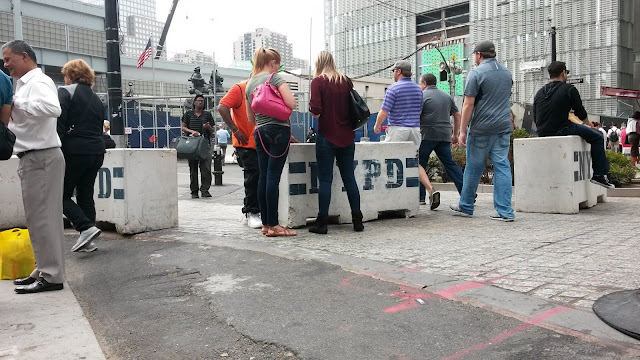Over the past couple decades, the NYPD has come to play a major role in urban design, although it generally passes without much notice. The police are responsible for securing dense urban areas against the threat of terrorism, as well as controlling crowds and traffic during special events. As part of these efforts, they routinely install physical barriers designed to stop vehicles. In many instances, the NYPD directly installs barriers. In other cases, they provide the requirements for designers to develop permanent installations more integrated into the streetscape.
The NYPD literally has tons of concrete blocks, which can be moved around the city to create temporary barriers wherever necessary. They tweeted about their concrete barriers during the Pope's visit:
Did You Know? 409 concrete barriers used citywide. That's 3,900lbs each, totaling 818 tons http://t.co/GJbbjYQzAU pic.twitter.com/HyQhbEN5wp
— NYPD NEWS (@NYPDnews) September 25, 2015
As a temporary measure used by the police, these blocks have a surprisingly high design quality. Cast with basic, inexpensive material, the white paint and simple "NYPD" letters stenciled in police blue provide a crisp, attractive look. These "temporary" installations sometimes remain for many years, as they have around the World Trade Center while construction continues. There are some benefits from the temporary precursors to permanent installations. It provides time to observe how the public interacts with these features. Hopefully observant designers take note of ways to use the barriers as multifunctional features that contribute to the enjoyable use of public space.One of the most common uses of the concrete barriers is sitting. This isn't surprising, given a general dearth of public seating in New York City. The blocks themselves are not ideal, since they are a little too high for true comfort. The height is generally set by security needs, but there may be possibilities to add a step that could help get up and down, while also serving as a foot rest.
One problem that frequently emerges with these chunky blocks, however, is a lack of sidewalk width for people to actually walk through. This can be aggravated when people sit on them, protruding further into what little sidewalk width remains. Additional effort is needed to understand how to deal with this issue, whether by developing staggering patterns or other means to maintain an effective barrier against vehicles while ensuring sufficient permeability for pedestrians.
Another style of barrier sometimes deployed in somewhat more permanent locations by the NYPD are oversized planter tubs. These are widely used around their headquarters at One Police Plaza. Many private buildings use variants of this as well. While the notion of greening the city is a wonderful idea, in practice the plants often die and the tubs become filled with trash. There are a lot of cigarette butts. Perhaps the butts kill the plants. Unless installed at a location with active management that will be diligent in cleaning and caring for the plants, planters should probably be avoided. If a building or business improvement district is willing to make the commitment, they may have a little more potential, though they still often tend to appear awkwardly out of scale.
The barriers usually mark entrances into pedestrian precincts, since their very purpose is to prevent vehicles from entering. There is potential for more interesting urban spaces to emerge through the use of the planters, to the extent they can be properly maintained. An outline of the possibilities can be seen at the main entrance to One Police Plaza. With trees that have started to reach a moderate height, arranged with a little stagger, the planters almost create a layered transitional space, which people move through before arriving at police headquarters. With some intentional design, this could become an exciting, engaging experience.
The Wall Street area has some of the few permanent installations where real design has been applied to integrate the security barriers into the streetscape. The treatments developed by Marvel Architects were developed to contribute to public use of the streets.
Here's how Marvel describes their award-winning design:
This project recognize the need to address new security requirements as yet another layer in the complex, pedestrian oriented, public realm. The project provides security and streetscape enhancements for the New York Financial District, including the New York Stock Exchange. We reconceived the security requirements outlined by the NYPD Counterterrorism Division as an opportunity to enhance the public space around one of America's most iconic buildings. The approach resolves the contradictions of enabling a vibrant streetscape while providing cutting-edge security in one of New York's densest urban conditions. Innovative security designs include sculptural bronze NOGO barriers that simultaneously replace bollards and provide attractive seating...Despite the somewhat uncomfortable height dictated by the security requirements, the barriers are well used as seating, as envisioned. As one of the first permanent designs, Marvel's effort is strong and hopefully sets the direction for subsequent designs. Continuing to observe how the public uses temporary locations, as well as the permanent designs that are gradually installed, will only improve the way these new features are incorporated into the cityscape.










This comment has been removed by a blog administrator.
ReplyDelete